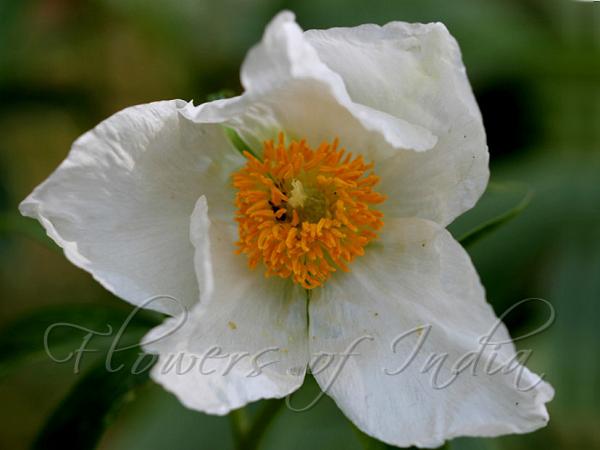|
| Himalayan Peony |
|

|

| File size | 82083 |
| Original date | 5/17/12 3:33 PM |
| Resolution | 828 x 621 |
| Flash | Flash did not fire |
| Focal length | 100.0mm |
| Exposure time | 1/200s |
| Aperture | 3.5 |
| Focus Distance | |
| Metering Mode | Multi-segment |
| Camera make | Canon |
| Camera model | Canon EOS 550D |
| Sensor type |
|
|
|
|
Photo: |
Botanical name: Paeonia emodi Family: Paeoniaceae (Peony family)
Himalayan Peony is a robust shrubby perennial,
30-75 cm tall, characterised by large white flowers with numerous
orange-yellow stamne and large deeply cut leaves. Flowers are 8-12 cm
across, with 5-10 elliptic petals and 5 persistent outer sepals. Leaves
are compound, 1-2 ft long, with lanceshaped long-pointed leaflets or
lobes up to 14 cm long. Fruit is 3-4 cm, densely hairy or hairless,
with seeds which are scarlet and then brown-black. Himalayan Peony is
found in the Himalayas, from Afghanistan to W. Nepal, at altitudes of
1800-2500 m. Flowering: April-May.
Medicinal uses:  The tubers of Himalayan Peony are a useful medicine for the treatment
of hysteria, convulsions, colic, uterine diseases and obstructions of
the bile duct. They are given to children as a blood purifier. The
seeds are cathartic and emetic. An infusion of the dried flowers is
useful in the treatment of diarrhoea. A tea made from the dried crushed
petals of various peony species has been used as a cough remedy, and as
a treatment for haemorrhoids and varicose veins.
The tubers of Himalayan Peony are a useful medicine for the treatment
of hysteria, convulsions, colic, uterine diseases and obstructions of
the bile duct. They are given to children as a blood purifier. The
seeds are cathartic and emetic. An infusion of the dried flowers is
useful in the treatment of diarrhoea. A tea made from the dried crushed
petals of various peony species has been used as a cough remedy, and as
a treatment for haemorrhoids and varicose veins.
 The tubers of Himalayan Peony are a useful medicine for the treatment
of hysteria, convulsions, colic, uterine diseases and obstructions of
the bile duct. They are given to children as a blood purifier. The
seeds are cathartic and emetic. An infusion of the dried flowers is
useful in the treatment of diarrhoea. A tea made from the dried crushed
petals of various peony species has been used as a cough remedy, and as
a treatment for haemorrhoids and varicose veins.
The tubers of Himalayan Peony are a useful medicine for the treatment
of hysteria, convulsions, colic, uterine diseases and obstructions of
the bile duct. They are given to children as a blood purifier. The
seeds are cathartic and emetic. An infusion of the dried flowers is
useful in the treatment of diarrhoea. A tea made from the dried crushed
petals of various peony species has been used as a cough remedy, and as
a treatment for haemorrhoids and varicose veins. Identification credit: Gurcharan Singh
| Photographed between Aishmuqam and Pahalgam, Kashmir. |